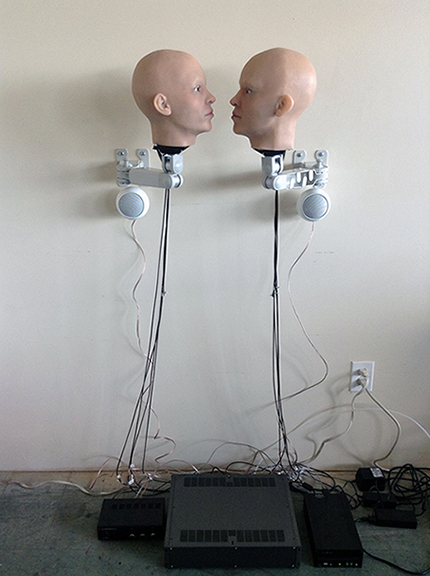
In this work, everything is "laid bare". There is no hiding of the components, nor any attempt to create visitor interaction. The two heads engage in endless conversations in which they struggle to communicate. Despite literally "understanding" what the other is saying, their utterances continuously destabilize each other's narrative because they actually understand nothing at all.
"For me personally it has something to do with the desire for connection and the sort of oceanic feeling that is
generated by the experience of that. These works of mine explore the impossibility of creating that through
language when there is no reality of the person. So the figures in the works, and especially in Hell, have a sort of
the appearance of being frustrated all the time. And it's important to note that it's always a referential
experience. The work evokes things in the viewer but the figures don't feel anything at all don't really think
anything at all. That's not always understood by the viewer. The situation is theatrical and even though it is largely
improvised, the conversation is staged. The figures are "as-if" they are actors. "As-if" operates in many realms in
this work. So the figures are trying to connect, but they don't really have any affect states but only the ability to
speak about them. They're constantly searching for something that will reaffirm their desire to connect with the
other one. And it's always undermined. It's always thwarted. It never gets to the point where they can settle into
a loving conversation."
from "Love is a Good Place to Start: Interview with Ken Feingold" by Edward Shanken, published in Ken Feingold: Figures of Speech , Centre for Contemporary Art LAZNIA, Gdansk 2014
transcript of a conversation:
She: You feel stubborn.
He: I love you.
She: You can be emotional sometimes.
He: I love you.
She: How can it be?
He: I love you.
She: At times I feel I want to discuss you.
He: You love me to be so irritated?
She: Do you doubt it?
He: What do you think?
She: Love is angry.
He: Sometimes I want to concoct you.
She: That's nice.
He: Sometimes you are sharp.
She: So you say.
He: I can never be so impatient.
She: Why not? Never ever?
He: Who knows?
She: At times I feel I want to disturb you.
He: I love you.
She: How can it be?